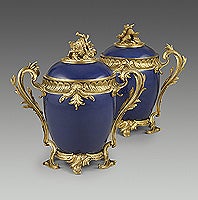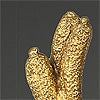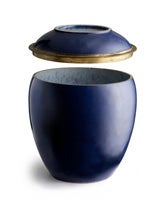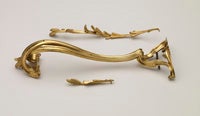| |
 |
|
|
| |
Pair of Deep Blue Chinese Porcelain Jars with French Gilt-Bronze Mounts
Porcelain, China, 1st half of the eighteenth century
Gilt-bronze mounts, France, 1745-49
1915.8.41: 17 7 ⁄8 x 18 5 ⁄8 x 10 11 ⁄16 in (45.4 x 47.3 x 27.1 cm);
1915.8.42: 18 7 ⁄16 x 18 5 ⁄8 x 10 5 ⁄8 in. (47 x 47.3 x 27 cm).
The Frick Collection, New York
(photo: Michael Bodycomb) |
|
|
In 1915 Henry Clay Frick acquired a magnificent group of eighteenth-century objets d’art to complete the décor of his new home at 1 East 70th Street. Among these was the striking pair of large mounted porcelains that is the focus of the Frick’s Cabinet installation. Visually splendid, delightfully inventive, and quintessentially French, the jars fuse eighteenth-century French collectors’ love of rare Asian porcelains with their enthusiasm for natural exotica. Assembled in Paris before 1750, the Frick jars are a hybrid of imported Chinese porcelain and French gilt-bronze mounts in the shape of imitation bulrushes (curling along the handles) and shells, sea fans, corals, and pearls (on the lids). Displayed alongside the two jars are French drawings and prints as well as actual seashells and corals, all from New York collections. Together, the objects illustrate the convergence of the natural and the humanly wrought in the production of such luxury wares and probe the fascination with the exotic that lies at the heart of Rococo design.
 |
 |
 |
 |
| bulrushes (detail) |
pearls (detail) |
shell (detail) |
coral (detail) |
 The cobalt-blue porcelains were produced in China in the first half of the eighteenth century, when dense, homogeneous monochrome glazing was perfected. Because porcelains glazed with a single color were manufactured primarily for the domestic Chinese market, relatively few of them made their way to France in the eighteenth century. Those that did were particularly prized and especially costly. Originally, the Frick porcelains were probably tall vases or jars but, on their arrival in Paris, they were cut — at the neck and again at the shoulder — to form lidded jars. These modifications may have been undertaken to salvage a chipped or broken porcelain, although at this time in Paris it was common practice to saw apart Asian porcelains in order to create new forms that could then be fitted with finely chased gilt-bronze mounts. A tax stamp, in the form of a crowned C, indicates that the Frick mounts were cast between 1745 and 1749. (However, since the same stamp also was applied to items on the art market during those years, it is not impossible that the mounts were made earlier.) Embellished with gilt bronze to conform to eighteenth-century French taste, the jars most likely graced the home of a French nobleman or a wealthy financier before traveling, at some point, to London, where the dealer Joseph Duveen purchased them at auction in 1913 from the estate of Henry M. W. Oppenheim and subsequently sold them to Frick. The cobalt-blue porcelains were produced in China in the first half of the eighteenth century, when dense, homogeneous monochrome glazing was perfected. Because porcelains glazed with a single color were manufactured primarily for the domestic Chinese market, relatively few of them made their way to France in the eighteenth century. Those that did were particularly prized and especially costly. Originally, the Frick porcelains were probably tall vases or jars but, on their arrival in Paris, they were cut — at the neck and again at the shoulder — to form lidded jars. These modifications may have been undertaken to salvage a chipped or broken porcelain, although at this time in Paris it was common practice to saw apart Asian porcelains in order to create new forms that could then be fitted with finely chased gilt-bronze mounts. A tax stamp, in the form of a crowned C, indicates that the Frick mounts were cast between 1745 and 1749. (However, since the same stamp also was applied to items on the art market during those years, it is not impossible that the mounts were made earlier.) Embellished with gilt bronze to conform to eighteenth-century French taste, the jars most likely graced the home of a French nobleman or a wealthy financier before traveling, at some point, to London, where the dealer Joseph Duveen purchased them at auction in 1913 from the estate of Henry M. W. Oppenheim and subsequently sold them to Frick.
 Although the mounts can be dated with some precision, their designer is unknown. Their quality is, however, undeniable. Their dynamic form and contrasting smooth and textured surfaces break up rays of light; in combination with the jars’ reflective properties — a characteristic for which monochromes were especially appeciated — the effect is one of sparkling, scintillating exuberance. Arranged on Boulle pedestals, veneered or lacquered tables, or in front of mirrors, mounted porcelains were essential to the décor of French townhouses and châteaux. Adorned with a profusion of such objects, eighteenth-century French interiors seduced the eye (and sometimes, if contemporary novelists are to be believed, the heart), producing, as one observer wrote in 1749 of the financier Blondel de Gagny’s Parisian home, “an effect so surprising that the viewer is captivated and will not leave this refuge of so much beauty without pain and without the desire to see it again and again.” In their reliance on natural forms, these objects are superb exemplars of Rococo design, which emerged in Paris in the 1730s and remained in vogue until the 1750s. Although the mounts can be dated with some precision, their designer is unknown. Their quality is, however, undeniable. Their dynamic form and contrasting smooth and textured surfaces break up rays of light; in combination with the jars’ reflective properties — a characteristic for which monochromes were especially appeciated — the effect is one of sparkling, scintillating exuberance. Arranged on Boulle pedestals, veneered or lacquered tables, or in front of mirrors, mounted porcelains were essential to the décor of French townhouses and châteaux. Adorned with a profusion of such objects, eighteenth-century French interiors seduced the eye (and sometimes, if contemporary novelists are to be believed, the heart), producing, as one observer wrote in 1749 of the financier Blondel de Gagny’s Parisian home, “an effect so surprising that the viewer is captivated and will not leave this refuge of so much beauty without pain and without the desire to see it again and again.” In their reliance on natural forms, these objects are superb exemplars of Rococo design, which emerged in Paris in the 1730s and remained in vogue until the 1750s.
Eighteenth-century artists and collectors were fascinated by nature’s wonders, especially shells, the most spectacular of which were believed to come from the East (like porcelains). This interest in shells was a significant factor in the development of the rocaille, as Rococo ornament was called at the time. (The term rocaille originally referred to the shell- and rock-work decoration of garden grottoes but, by the mid-1730s, it was used to describe the asymmetrical and irregular forms of the rococo that were inspired by shells and other natural forms.) Equally important was the contemporary appreciation of works in which the marvels of nature and human ingenuity were conjoined. Actual shells and corals were frequently set into gilt-bronze mounts, as were Asian porcelains in the shape of shells. Like these objects, the gilt-bronze imitations of marine life and freshwater bulrushes found on the Frick jars blur the boundaries between the natural and the artificial, dazzling the senses with their artful play between the beautiful creations of nature and the inspired invention of the artisan.
— Kristel Smentek, Andrew W. Mellon Curatorial Fellow
Rococo Exotic: French Mounted Porcelains and the Allure of the East is accompanied by a fully illustrated publication that features an introduction by Chief Curator Colin B. Bailey as well as an essay by Andrew W. Mellon Fellow Kristel Smentek, catalogue entries, and a bibliography. It is available in the Museum Shop of The Frick Collection.
|


